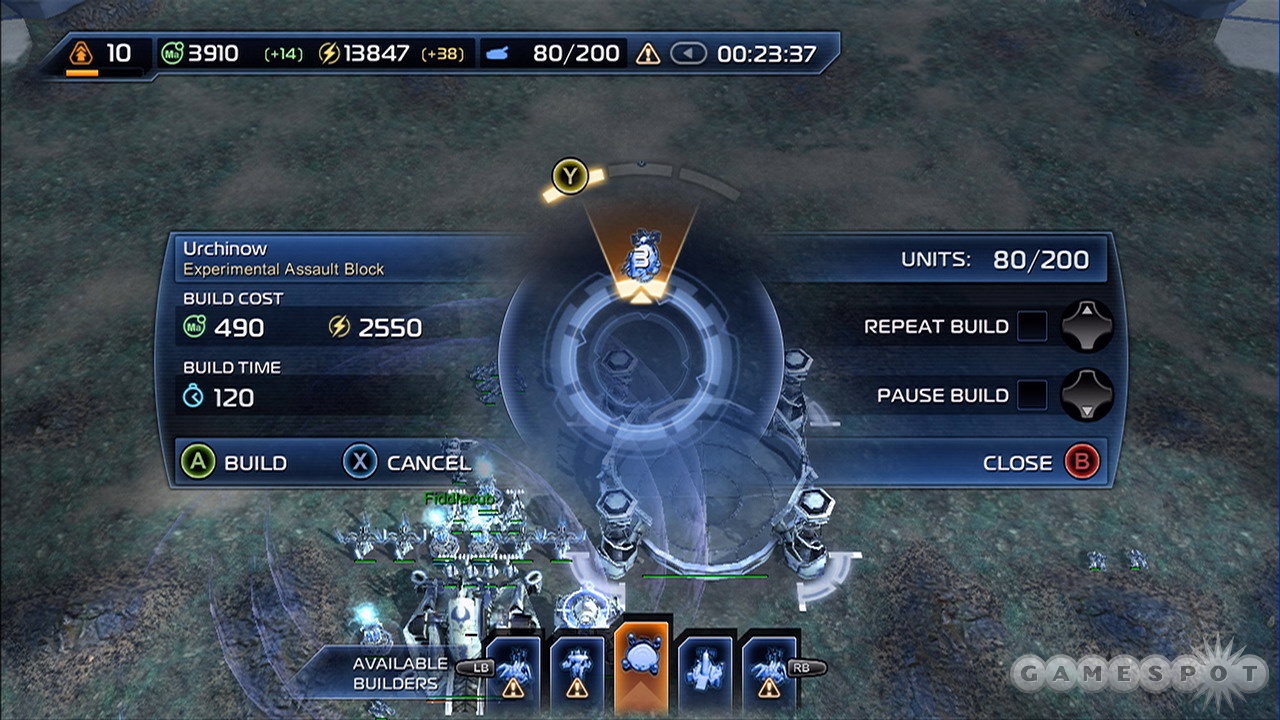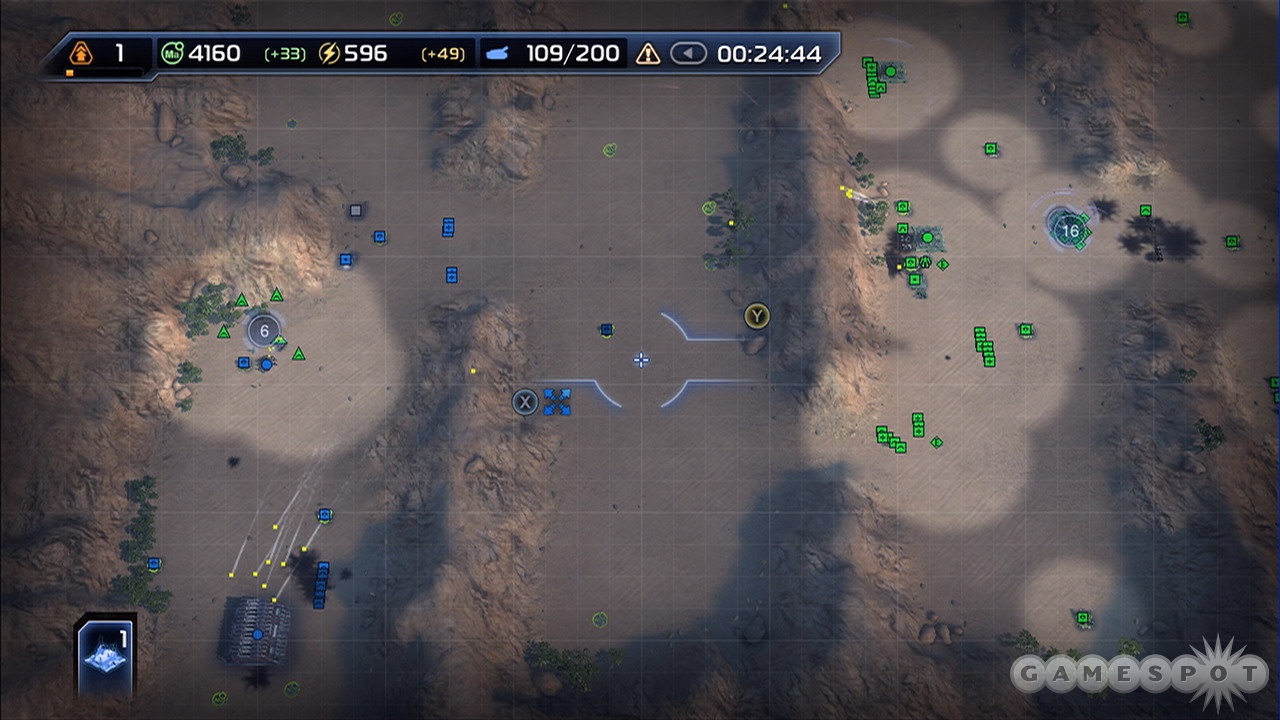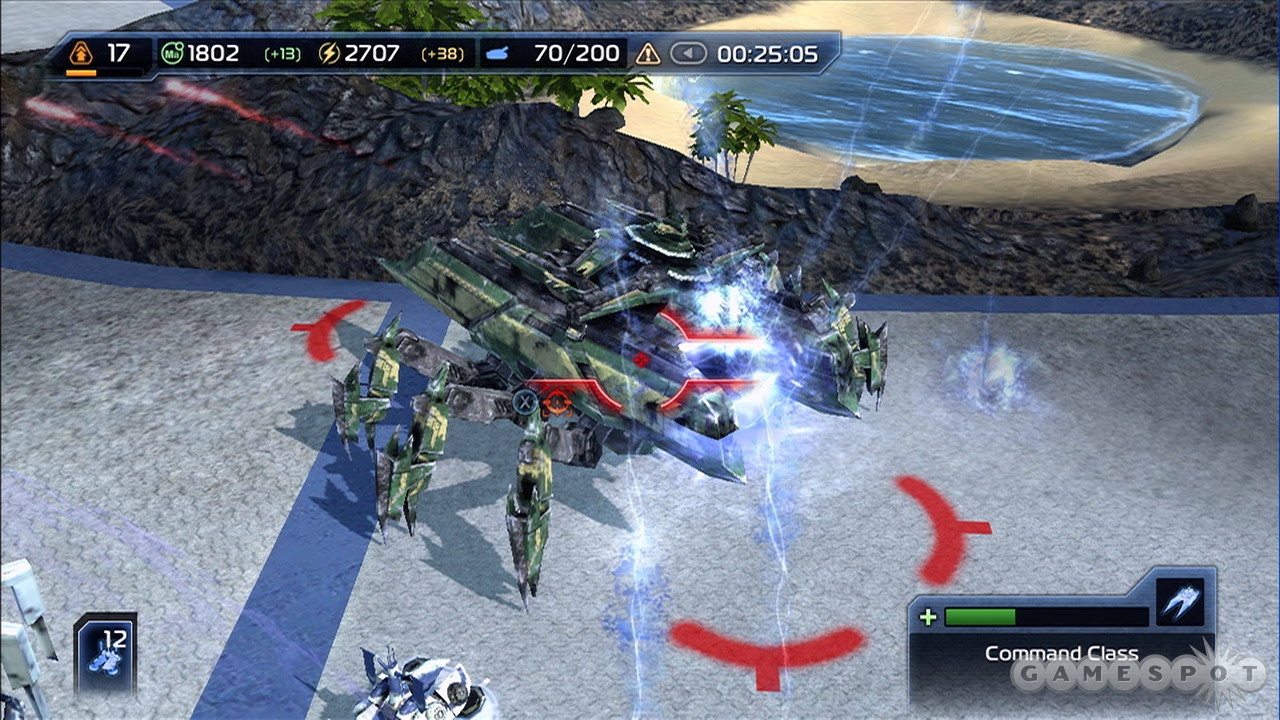The original Supreme Commander made waves on the PC, but on the Xbox 360, it barely managed a ripple. Bad bugs and abysmal engine performance overshadowed the satisfying and complex strategizing and made the game excruciating to play. If you were cautiously considering picking up the sequel, rest assured that Supreme Commander 2 suffers from few of its predecessor's visual problems. This is an inviting package for both veterans and newcomers--intricate enough to keep your mind nimble but welcoming to those daunted by the original's magnitude. Most importantly, it's good fun, letting you play with a variety of interesting units and giving you lots of room to experiment with all the tactical possibilities. The strategic joy doesn't go unhindered, however; pathfinding headaches, sound bugs, and predictable AI keep Supreme Commander 2 from reaching its potential. Yet while it isn't likely to challenge experienced armchair commanders, it still stands out for its fluid gameplay, excellent multiplayer maps, and the thrill of emerging victorious from a long battle of wits.
If you played the original Supreme Commander on the Xbox 360, you'll notice right away that Supreme Commander 2 performs far, far better than its predecessor. The original suffered from massive frame rate drops that greatly damaged the experience. Apart from a few hiccups here and there, SupCom 2 maintains a solid frame rate, even during one of the game's signature nuclear explosions. The sequel isn't visually remarkable; textures are bland, colors look a bit washed out, and units lack the crisp detail you'd hope to see in a game featuring big robots. Yet while your first impression might be one of surprise at how dull SupCom 2 looks, you'll soon grow to appreciate how pleasantly smooth it feels to move about the battlefield, even when you zoom all the way out to get a godlike view of the proceedings. One area in which the sequel has not improved over the original, however, is in its sound design. Like its precursor, Supreme Commander 2 does a terrible job of scaling its audio and often sounds as if it's trying to stuff more sound effects through your speakers than it's capable of delivering. Battles often sound uncomfortably abrasive, and sometimes the noise will cut out completely for a few moments after a particularly harsh explosion.
The game may not push many polygons or provide pitch-perfect audio, but it does sport plenty of personality and verve. You battle in misty mountaintops connected by a series of bridges and fend off hulking robots within towering industrial complexes. The environments benefit from a distinct sense of place, though the art design won't floor you and a general lack of crispness muffles the overall look. Still, Supreme Commander 2 has more style than its predecessor, which took a more matter-of-fact approach to its visual flourishes. The story also boasts a distinct personality, following three military commanders that met during training after three warring factions--the United Earth Federation (or UEF), the Cybran Nation, and the Illuminate (formerly the Aeon Illuminate)--formed a coalition to destroy the invading Seraphim. The character models that appear in cutscenes and within talking-head story updates have a stylized, almost cartoonish look that sometimes seems at odds with the dignity and drama of the main story. (Some campy dialogue and hammy acting don't help matters, either.) Nonetheless, these characters provide an intimate view of the conflict that puts an end to the tenuous treaty, and they're appealingly scrappy, which makes it easy to root for them.
You get to know them as you make your way through Supreme Commander 2's single-player story, which features 18 missions--six for each faction. There's a nice sense of forward momentum to the campaign, which opens up features and units to you over time, but it does so without holding your hand every step of the way. The first couple of missions for each faction might take you 15 minutes or so, but the biggest ones might last close to an hour and keep you occupied on multiple fronts. It's an excellent campaign, getting you into the fray quickly and letting you focus on strategy rather than on the "take these few units over here" objectives that all too often invade real-time strategy games. If you play on normal difficulty, don't expect much of a challenge: Supreme Commander 2 is rather easy, so if you've played a strategy game before, you may want to turn the difficulty up a notch. However, there is usually a lot going on, with some missions throwing enemies at you from the get-go and others forcing you to build a base from scratch. Fortunately, Supreme Commander 2 utilizes a simple control scheme that makes it easy to manage everything at once. Some additional options and tweaks would have been welcome. It can be cumbersome to search for idle engineers, for example, and there is no way to create custom control groups. While a traditional strategy game like this one invariably feels better on the PC, the console controls are as comfortable as you'd hope for and better than those of the original Supreme Commander on the Xbox 360.

One of Supreme Commander 2's best assets is that gives you room to play with the units at your disposal. Each faction's units are similar, but they aren't exact mirrors. For example, while the UEF boasts multiple land vehicles that meet specific needs, the catch-all antimissile/antiair Cybran adaptor fulfills multiple roles at once. The UEF and Cybran factions possess capable naval units--but Illuminate players do not get a navy at all, though their hovering ground units won't leave them landlocked. The differences are sometimes subtle, but they're palpable enough to make each faction feel unique. You won't find the factional variety of a game like Universe at War or even StarCraft, but the upside is that factions are beautifully balanced and don't require a complete shift of gears when moving from one faction to the next.
As before, each faction uses similar methods to accumulate resources: by collecting mass from predetermined nodes using mass extractors and by building generators to produce energy. There are some notable changes to the formula here. In Supreme Commander, your available resources didn't limit your build queue; you could essentially order up new units and structures "on credit." Now, you can only spend the funds if you have them, which is a change that may disappoint some SupCom loyalists. The other major difference is the complete removal of unit tiers. Units are upgraded via research points that you accumulate by building research centers; the more you build, the faster you earn those valuable points. Your research trees are divided into multiple categories (air, ground, structure, and so on) and follow multiple paths that let you unlock new units and structures, as well as improve existing ones. For example, you can add an extra barrel to your tanks and a personal shield to your gunships. Most significantly, you can also gain access to the all-important experimental units and, yes, the nukes that caused you so much joy and heartache in the first game.
The economic changes aren't for the worse or even necessarily for the better, but they do place the focus squarely on moment-to-moment battle decisions rather than convoluted economic tweaking. You spend less time speeding up production times with engineers and more time spreading your units around and reacting to your opponents' actions. Matches give you a chance to play with different ideas and a reason to use every unit at your disposal. If you like turtling, shield generators and long-range artillery will buy you time to amass a large force. If you like harassing the enemy, stick to the air and put your bombers on a patrol route. Your base building isn't restricted to a specific region, and the research trees are generous and robust, so there's plenty of room to be creative. The flexibility leads to a ton of fun because on the best maps, no game plays out the same way twice. An intense battle may erupt when you least suspect it, or you might foil your nemesis' plans with a well-timed artillery barrage. And if you can't decide whether to be conservative or aggressive, spread your forces quickly and be both at once. Imagination is often rewarded with shocking and exciting victories, though crazy strategies may naturally lead to soul-crushing defeat as well.

The game-changing experimental units give you even more flexibility and can change the flow of battle in awesome ways. Some of them, such as the UEF's returning (and slightly tweaked) fatboy and the gigantic King Kriptor robot, are offensive powerhouses and as subtle as a destructive blast to the forehead. Others, however, take a bit more skill and produce much more unexpected and enjoyable results. A well-considered placement of the Illuminate's loyalty gun will convert invading experimentals to your cause, so that a hulking Cybranosaurus might end up mowing down its previous comrades. The space temple teleporter helps you take your enemy unaware, and using it multiple times in a row may lead to several concurrent scuffles. If you want more dramatic invasions, however, you can build some ground units within the UEF's land cannon and shoot them across the map into enemy territory. It sure beats a boring old transport ship.
Rarely would you ever call Supreme Commander 2 boring, however. The net result of the changes--the adjusted economy, the speed at which you can earn experimentals and upgrades--is that you don't need to wait a long time to get the fun units in play. It takes time to unlock high-cost experimentals, but the less-expensive ones are fun to watch and fun to use, and you can put them in play early on. This is a game in which you can pit colossal robots and hulking metal dinosaurs against each other, and the pace of the campaign is excellent, keeping you excited to see what toys the game is going to give you next while making it fun to use the ones you have. The game's conventional but rousing soundtrack hits the right notes, and the resulting tension is constantly relieved by massive explosions and frenzied masses of tangling aircraft.
After you cut your teeth on the single-player campaign, you can easily jump into online play to challenge human opponents. You can join up with friends or play ranked or unranked matches against strangers, though a week after release, there aren't many people playing online, so you'll need to exercise some patience if you're hoping to rise up the leaderboard ranks. The maps only support up to four players, but most are designed well and give you a chance to spread your forces quickly. Online matches run smoothly and provide the game's finest pleasures, mostly in the broader maps that smartly avoid a lot of choke points and narrow walkways. A seemingly staid opponent may suddenly launch nuclear death from above, teleport in a couple of powerful assault blocks, or take out all of your air units with a few antiair experimentals. Everything can go from cerebral to stimulating within a moment's notice. Of course, if you need practice, you can always play offline skirmishes, but the AI on normal doesn't provide much more challenge in one-off matches than it does in the campaign.

The narrow walkways of other maps highlight one of Supreme Commander’s more notable problems: pathfinding. Ground units may have trouble figuring out how to arrange themselves or get through not-so-narrow gaps, even performing occasional dance routines as they attempt simple move orders. An experimental might get stuck on a defeated unit's charred remains or your armored command unit may wedge itself between structures, though most pathfinding flaws are far less problematic. These moments might happen even when you've taken care to avoid them, and micromanaging units just to get them to where you need them to go is not a welcome diversion. These frustrations aren't common, but they are noticeable nonetheless.
Whether you're a newcomer or a veteran tactician, you'd do well to overlook the flaws and enjoy Supreme Commander 2 for being so fun and approachable. The game maintains a difficult balancing act, providing the flexibility of the original Supreme Commander with a user-friendly makeover that lends some freshness and personality. This isn't the next step forward in console strategy games, but it controls well and performs well, making it easy to get lost in some entertaining robot-on-robot action.